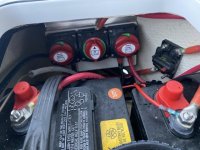DSigmond
New member
- Joined
- Apr 9, 2016
- Messages
- 11
- Reaction score
- 0
- C Dory Year
- 2007
- C Dory Model
- 22 Cruiser
- Hull Identification Number
- WN7747NU
My 22 Cruiser has start and house batteries that are independent unless their switch is set to "Both" for charging while underway. I'm aware that a forgetful me could kill them both, but my conundrum today is: Which one does the dashboard voltmeter read? More to the point, can I get a dual meter to monitor them independently?[/i]

